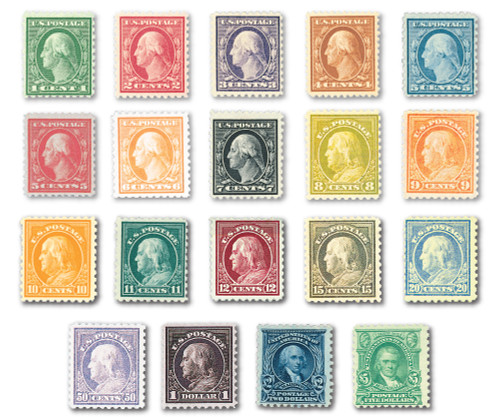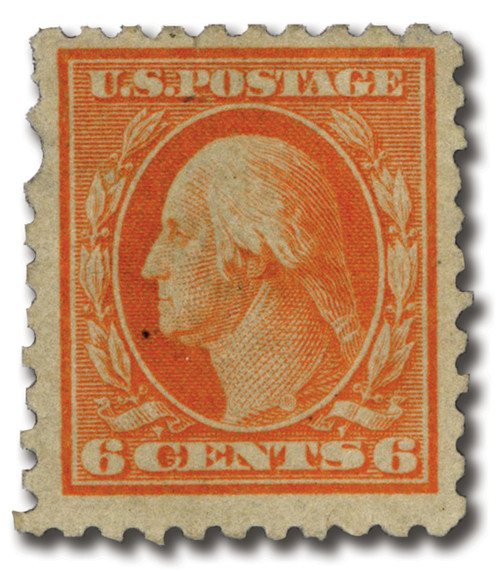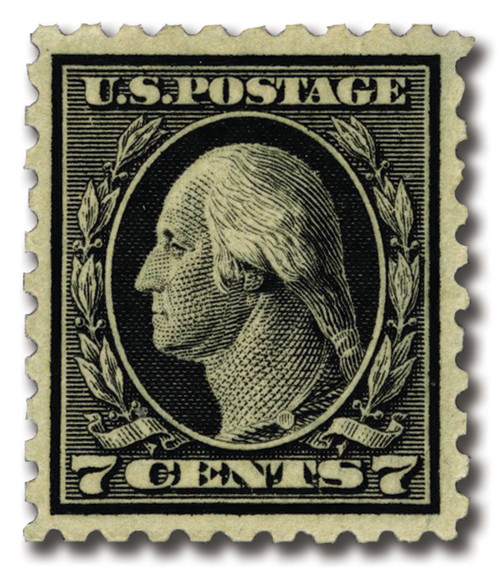
# 462-80 - Complete Set, 1916-17 Unwatermarked Perforated 10
Are You Missing These 1916-17 Regular Issue Stamps?
First Unwatermarked Stamps, Perforated 10
The Washington-Franklins are among the most fascinating and challenging US stamps to collect. Issued between 1908 and 1922, they encompassed over 200 varieties, five different designs, two paper types, three printing methods, at least 14 perforations, several colors, and 20 denominations.
You can come one step closer to completing your Washington-Franklin collection with this convenient set of 19 stamps. These were the first stamps to be printed on unwatermarked paper. Highlights from this set include:
US #462 – Referred to by respected philatelic author Max Johl as “one of the most desirable stamps of the 20th century."
US #463 – Fulfilled the standard domestic first class postal rate.
US #464 – Went “almost entirely overlooked during the short time it was current” according to Max Johl.
US #465 – Issued for only a few months and had several color shades. It paid the domestic first class rate for a letter weighing one to two ounces, or double the normal 2¢ rate.
US #466 – Primarily used to pay the postal rate for foreign mail.
US #467 – A 5¢ carmine error stamp that was printed right in the middle of a sheet of 2¢ stamps. Click here for the full story behind this odd error.
US #468 – Issued in limited quantities and did not have a specific use. It paid the domestic first class rate for a letter weighing two to three ounces (triple the normal domestic first class rate). When the postal rate increased from 2¢ to 3¢ during World War I, US #468 fulfilled double the new normal 3¢ rate.
US #469 – The first 7¢ denominated stamp since the 1871 issue. It had no specific use as a single stamp, but could be used in combination with other stamps for letters weighing over two ounces and small packages.
US #470 – Fit no specific postal rate, but could be used to pay multiple rates.
US #471 – Only about 665,000 issued.
US #472 – Paid the domestic registered mail fee and was current for only about five months and never produced in great numbers.
US #473 – This odd denomination didn’t serve any specific purpose. The original 11¢ denomination had been issued a year earlier for prepaying postage on parcels, and the insurance fee on parcels up to 11 cents.
US #474 – Paid the registered mail fee and domestic mail fee, combined.
US #475 – Only in use for 6 months. Used for Parcel Post and also paid the combined rates of registered mail and foreign mail.
US #476 – Often used to pay the higher Parcel Post fees.
US #477 – The much-anticipated changeover to Perf 11 gauges came just three weeks after the 50¢ Franklin was issued. As a result, few post offices requested stocks of the stamp and many never carried it. The confusion in identifying it against previous 50¢ Franklins on single watermark paper makes it even more scarce today, as many collectors overlooked #477 at the time.
US #478 – Often used to send parcels to Europe – especially Russia – during World War I. The abnormally high demand meant that most stamps were purchased for postal use, with fewer being set aside by collectors. While most of this series was printed on unwatermarked paper as a change from single marked paper, the $1 Franklin was never printed on single watermark paper.
US #479 – Used to send machine parts to Russia and also to send valuable Liberty Bond shipments.
US #480 – Used to send valuable Liberty Bond shipments, and also to pay for fund transfers between postal departments.
These last two stamps were rushed into production from 1902 plates and are the only ones in the set that don’t picture Washington and Franklin.
First Unwatermarked U.S. Stamps
In 1916, the Bureau of Engraving and Printing began producing stamps on unwatermarked paper. With the United States already close to a wartime economy as World War I raged in Europe, the lower cost of unwatermarked paper added up to big savings for the Bureau. However, single watermarks on previous stamps were often quite hard to identify, and collectors were slow to recognize that a new type of paper was being used.
Adding to the confusion was the continued use of 10 gauge perfs. A year earlier, 11 gauge perforations had been introduced, and the collecting community expected to see new stamps with that gauge. But in another cost-cutting move, the BEP continued to use the 10 gauge perforating rollers until they wore out completely. The Series of 1916 Washington-Franklins used the same design as previous stamps. Since it was easy to miss whether it was new unwatermarked paper or paper with faint single marks, many collectors overlooked these stamps when they were first issued.
Cost-cutting Efforts Add to Confusion
Adding to the confusion was the continued use of 10 gauge perfs. A year earlier, 11 gauge perforations had been introduced, and the collecting community expected to see new stamps with that gauge. But in another cost-cutting move, the BEP continued to use the 10 gauge perforating rollers until they wore out completely.
The Series of 1916 Washington-Franklins used the same design as previous stamps. Since it was easy to miss whether it was new unwatermarked paper or paper with faint single marks, many collectors overlooked these stamps when they were first issued.
Are You Missing These 1916-17 Regular Issue Stamps?
First Unwatermarked Stamps, Perforated 10
The Washington-Franklins are among the most fascinating and challenging US stamps to collect. Issued between 1908 and 1922, they encompassed over 200 varieties, five different designs, two paper types, three printing methods, at least 14 perforations, several colors, and 20 denominations.
You can come one step closer to completing your Washington-Franklin collection with this convenient set of 19 stamps. These were the first stamps to be printed on unwatermarked paper. Highlights from this set include:
US #462 – Referred to by respected philatelic author Max Johl as “one of the most desirable stamps of the 20th century."
US #463 – Fulfilled the standard domestic first class postal rate.
US #464 – Went “almost entirely overlooked during the short time it was current” according to Max Johl.
US #465 – Issued for only a few months and had several color shades. It paid the domestic first class rate for a letter weighing one to two ounces, or double the normal 2¢ rate.
US #466 – Primarily used to pay the postal rate for foreign mail.
US #467 – A 5¢ carmine error stamp that was printed right in the middle of a sheet of 2¢ stamps. Click here for the full story behind this odd error.
US #468 – Issued in limited quantities and did not have a specific use. It paid the domestic first class rate for a letter weighing two to three ounces (triple the normal domestic first class rate). When the postal rate increased from 2¢ to 3¢ during World War I, US #468 fulfilled double the new normal 3¢ rate.
US #469 – The first 7¢ denominated stamp since the 1871 issue. It had no specific use as a single stamp, but could be used in combination with other stamps for letters weighing over two ounces and small packages.
US #470 – Fit no specific postal rate, but could be used to pay multiple rates.
US #471 – Only about 665,000 issued.
US #472 – Paid the domestic registered mail fee and was current for only about five months and never produced in great numbers.
US #473 – This odd denomination didn’t serve any specific purpose. The original 11¢ denomination had been issued a year earlier for prepaying postage on parcels, and the insurance fee on parcels up to 11 cents.
US #474 – Paid the registered mail fee and domestic mail fee, combined.
US #475 – Only in use for 6 months. Used for Parcel Post and also paid the combined rates of registered mail and foreign mail.
US #476 – Often used to pay the higher Parcel Post fees.
US #477 – The much-anticipated changeover to Perf 11 gauges came just three weeks after the 50¢ Franklin was issued. As a result, few post offices requested stocks of the stamp and many never carried it. The confusion in identifying it against previous 50¢ Franklins on single watermark paper makes it even more scarce today, as many collectors overlooked #477 at the time.
US #478 – Often used to send parcels to Europe – especially Russia – during World War I. The abnormally high demand meant that most stamps were purchased for postal use, with fewer being set aside by collectors. While most of this series was printed on unwatermarked paper as a change from single marked paper, the $1 Franklin was never printed on single watermark paper.
US #479 – Used to send machine parts to Russia and also to send valuable Liberty Bond shipments.
US #480 – Used to send valuable Liberty Bond shipments, and also to pay for fund transfers between postal departments.
These last two stamps were rushed into production from 1902 plates and are the only ones in the set that don’t picture Washington and Franklin.
First Unwatermarked U.S. Stamps
In 1916, the Bureau of Engraving and Printing began producing stamps on unwatermarked paper. With the United States already close to a wartime economy as World War I raged in Europe, the lower cost of unwatermarked paper added up to big savings for the Bureau. However, single watermarks on previous stamps were often quite hard to identify, and collectors were slow to recognize that a new type of paper was being used.
Adding to the confusion was the continued use of 10 gauge perfs. A year earlier, 11 gauge perforations had been introduced, and the collecting community expected to see new stamps with that gauge. But in another cost-cutting move, the BEP continued to use the 10 gauge perforating rollers until they wore out completely. The Series of 1916 Washington-Franklins used the same design as previous stamps. Since it was easy to miss whether it was new unwatermarked paper or paper with faint single marks, many collectors overlooked these stamps when they were first issued.
Cost-cutting Efforts Add to Confusion
Adding to the confusion was the continued use of 10 gauge perfs. A year earlier, 11 gauge perforations had been introduced, and the collecting community expected to see new stamps with that gauge. But in another cost-cutting move, the BEP continued to use the 10 gauge perforating rollers until they wore out completely.
The Series of 1916 Washington-Franklins used the same design as previous stamps. Since it was easy to miss whether it was new unwatermarked paper or paper with faint single marks, many collectors overlooked these stamps when they were first issued.
















